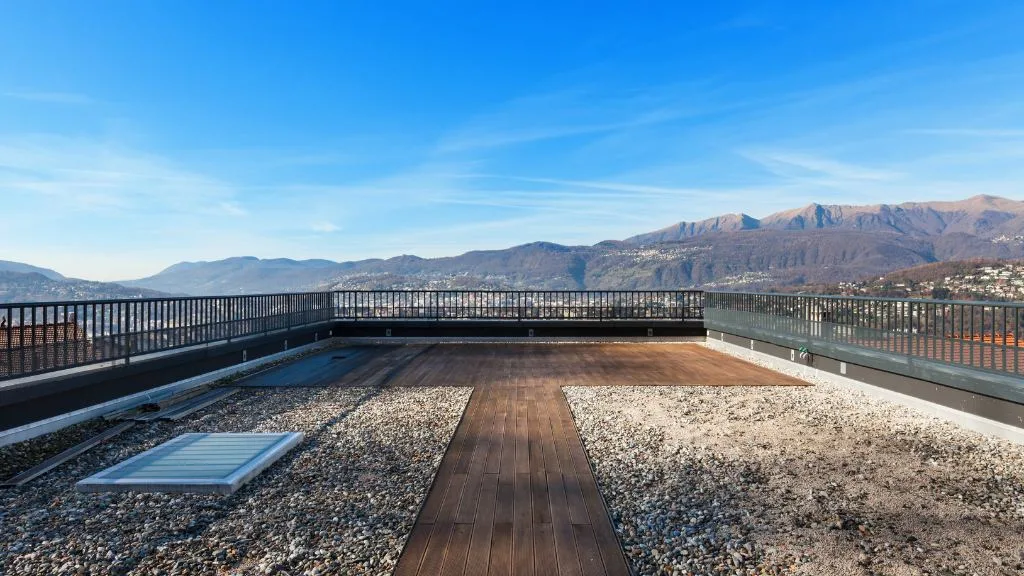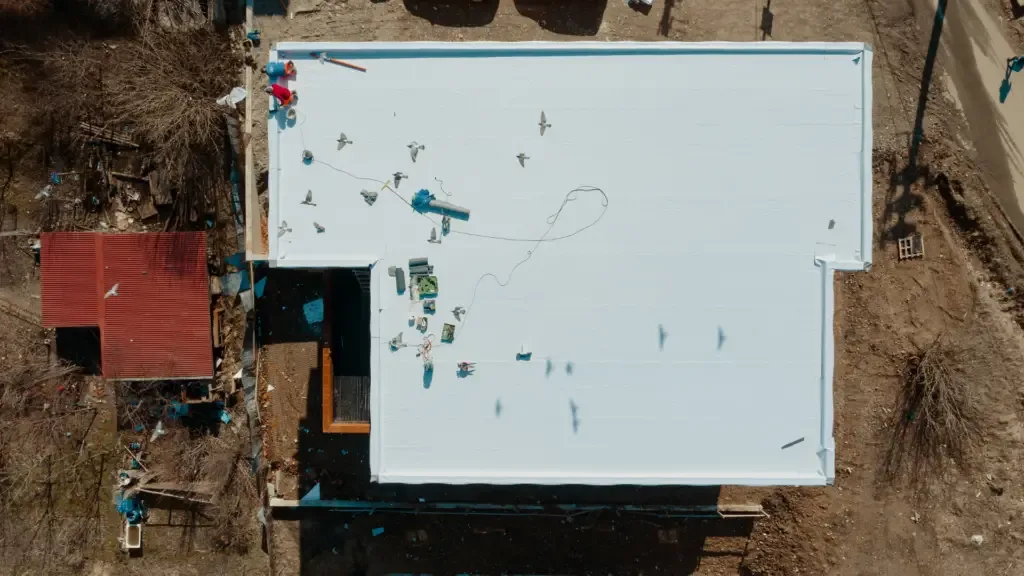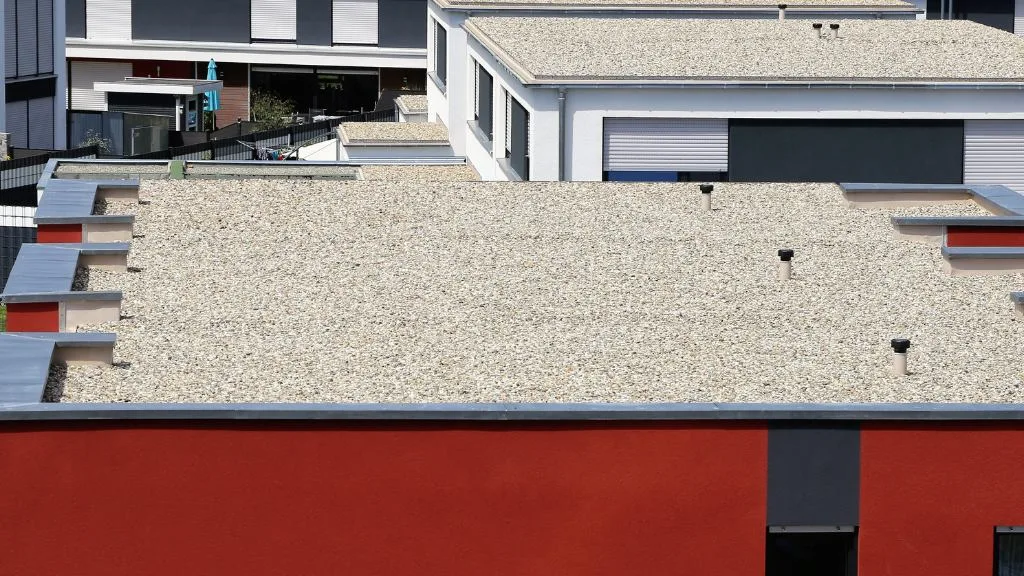
Are you looking for a roofing solution that’s both cost-effective and easy to install? A ballasted roof system may be just what you need.
This type of roofing uses large stones or pavers to hold the membrane in place, eliminating the need for adhesives or fasteners. Not only does this make installation quicker and easier, but it can also help reduce costs.
But what exactly is a ballasted roof system, and how does it work? In this article, we’ll explore the ins and outs of this innovative roofing solution, including its benefits, drawbacks, and whether it may be the right choice for your building.
What is a Ballasted Roof System?
If you are looking for a roofing system that is easy to install and cost-effective, a ballasted roof system might be the right choice for you. A ballasted roof system is a type of roofing that uses a loose-laid membrane held in place by ballast, which is usually gravel, pavers, or other heavy materials.
The ballast provides the weight that holds the membrane in place and counteracts the uplift forces caused by wind. This means that the membrane does not need to be anchored or adhered to the decking material, making the installation process faster and simpler than other roofing systems.
Ballasted roof systems are commonly used in large-scale retail stores and warehouses, where the open rooftops make them an ideal choice. They are also popular for their energy efficiency, as the ballast helps to insulate the building by reducing heat transfer.
The membrane used in a ballasted roof system can be made of various materials, including EPDM, polyethylene, and polypropylene. Single-ply membrane is a common choice for ballasted roofing systems because it is lightweight, flexible, and durable.
Overall, a ballasted roof system is a cost-effective and efficient option for those looking for a low-maintenance roofing solution. With its easy installation process and energy-saving benefits, it is a popular choice for commercial and industrial buildings.

Installation
Installing a ballasted roof system is a relatively easy process that requires a few key materials and steps. In this section, we will cover the materials needed and the process for installation.
Materials
To install a ballasted roof system, you will need the following materials:
- Membrane: A single-ply membrane that is loose-laid onto the roof deck.
- Insulation: A layer of insulation that is placed over the membrane.
- Ballast: A layer of stone or pavers that is placed over the insulation to hold the membrane in place.
- Fasteners: Fasteners are used to secure the edges of the membrane to the roof deck.
- Adhesives: Adhesives are used to secure the insulation to the roof deck.
Process
Here is a step-by-step guide to installing a ballasted roof system:
- Begin by preparing the roof deck. Ensure that it is clean, free of debris, and dry.
- Install the insulation over the roof deck, ensuring that it is properly aligned and secured in place using adhesives.
- Install the membrane over the insulation, ensuring that it is properly aligned and secured in place using fasteners.
- Once the membrane is installed, add a layer of ballast over the top of the membrane. The ballast should be evenly distributed and should cover the entire roof surface.
- Once the ballast is in place, inspect the roof to ensure that everything is properly aligned and secured. Make any necessary adjustments.
Overall, a ballasted roof system is relatively easy to install and requires only a few key materials. By following the steps outlined above, you can ensure that your ballasted roof system is properly installed and will provide long-lasting protection for your building.

Advantages of a Ballasted Roof System
If you’re looking for a roofing system that is durable, energy-efficient, and aesthetically pleasing, a ballasted roof system may be the right choice for you. Here are some of the advantages of a ballasted roof system:
Durability
Ballasted roofs are known for their durability. The stones or pavers used to hold the roofing membrane in place provide excellent protection against wind uplift and high winds.
The roofing membrane is also protected from foot traffic, making it less likely to be damaged.
Energy Efficiency
Ballasted roofs are also energy-efficient. The stones or pavers used in the system provide a layer of insulation, reducing energy costs and consumption.
In addition, ballasted roofs can be designed as cool roofs, reflecting solar radiation and reducing the urban heat island effect.
Aesthetics
Ballasted roofs can be aesthetically pleasing. The stones or pavers used in the system come in a variety of colors and shapes, allowing you to create a unique look for your roof.
In addition, the stones or pavers can be used to create walkways and other features, adding to the overall design of your building.
Foot Traffic
Ballasted roofs are designed to withstand foot traffic. The stones or pavers used in the system provide a stable surface for people to walk on, reducing the risk of slips and falls.
In addition, the stones or pavers can be used to create walkways and other features, making it easier for people to move around your building.
In summary, a ballasted roof system is durable, energy-efficient, aesthetically pleasing, and designed to withstand foot traffic. If you’re looking for a roofing system that can provide these benefits, a ballasted roof system may be the right choice for you.

Maintenance and Repair
Maintaining a ballasted roof system is relatively easy and straightforward. Regular inspections will help identify any potential issues before they become major problems.
Here are some tips for maintaining and repairing a ballasted roof system:
- Inspect the roof regularly: Regular inspections can help identify any potential issues before they become major problems. You should inspect your roof at least twice a year, ideally in the spring and fall.
- Clean the roof: Keeping the roof clean can help prevent debris from building up and clogging the drainage system. You can use a broom or leaf blower to remove debris from the roof.
- Check for leaks: If you notice any water stains on the ceiling or walls, it could be a sign of a leak. You should inspect the roof for any signs of damage or wear that could be causing the leak.
- Repair any damage: If you notice any damage to the roof, such as punctures or tears, you should repair it as soon as possible. Small repairs can be done using a patch kit, while larger repairs may require the help of a professional.
- Replace ballast as needed: Over time, the ballast on the roof may shift or become displaced. You should check the ballast periodically and replace it as needed to ensure that the roof is properly protected.
- Address seam issues: While ballasted roofs do not have seams, if you have a ballasted roof with seams, you should inspect them regularly for any signs of damage or wear. If you notice any issues, you should repair them as soon as possible to prevent leaks.
- Protect the roof from inclement weather: While ballasted roofs are designed to shield the membrane from inclement weather, you should still take precautions to protect the roof during severe weather events. For example, you may want to remove any loose objects from the roof before a storm to prevent them from becoming projectiles.
Overall, maintaining a ballasted roof system is relatively easy and straightforward. Regular inspections and repairs can help ensure that your roof lasts for many years without any major issues.

Costs
If you are looking for an economical roofing option, a ballasted roof system is definitely worth considering. The installation process is fast and easy, which makes it an affordable option for large, open rooftops.
Ballasted systems feature a loose-laid membrane held in place by stone or pavers, which helps to shield the membrane from inclement weather and extend its lifespan.
One of the benefits of a ballasted roof system is that it can help reduce energy costs. The ballast acts as an insulator, which helps to keep the building cooler in the summer and warmer in the winter.
A system with a weight of 17 pounds per square foot saves as much energy as an ENERGY STAR-rated reflective roof. This can help you save money on your energy bills in the long run.
However, it’s important to note that ballasted roof systems can also have some costly issues. For example, finding small punctures can be difficult because dirt and dust can get trapped in between the stone.
The only way to see the membrane is to move the ballast, which means somebody has to shovel stone out of the way. This all takes time and can cost the building owner more money.
In addition, if the ballast is not installed correctly, it can shift over time and cause damage to the membrane. This can lead to leaks and other costly repairs.
It’s important to work with a professional roofing contractor who has experience with ballasted roof systems to ensure that the installation is done correctly and the ballast is properly maintained.
Overall, a ballasted roof system can be a cost-effective and energy-efficient option for your building. However, it’s important to weigh the pros and cons and consider all of the costs involved before making a decision.

Types of Ballast
When it comes to ballasted roof systems, there are several types of ballast that can be used. Here are some of the most common types:
Gravel
Gravel is a popular choice for ballast because it is readily available and relatively inexpensive. It is also heavy enough to hold the roofing membrane in place, even in high winds.
However, gravel can be difficult to install and may require additional layers of protection to prevent punctures in the roofing membrane.
Pavers
Pavers are another common choice for ballast. They come in a variety of materials, including concrete, stone, and clay.
Pavers are easy to install and can be arranged in a variety of patterns to create a visually appealing roof. However, they can be more expensive than other types of ballast and may require additional support to prevent cracking.
Recycled Materials
Recycled materials, such as crushed glass or rubber, can also be used as ballast. These materials are environmentally friendly and can be a cost-effective option.
However, they may not be as heavy as other types of ballast and may require additional layers of protection to prevent damage to the roofing membrane.
Stones
Stones are a traditional choice for ballast and can be made from a variety of materials, including granite, limestone, and river rock. They are heavy enough to hold the roofing membrane in place and can be arranged in a variety of patterns to create a unique look.
However, stones can be more expensive than other types of ballast and may require additional support to prevent shifting.
Overall, the type of ballast you choose will depend on a variety of factors, including cost, availability, and aesthetic preferences. Consider working with a professional roofing contractor to determine the best type of ballast for your specific needs.
Conclusion
In conclusion, a ballasted roof system is a cost-effective and easy-to-install roofing solution that is suitable for a variety of applications, including retail stores, warehouses, and residential buildings.
This roofing system is particularly popular for large, open rooftops, where it can be installed quickly and efficiently.
One of the key benefits of a ballasted roof system is its energy efficiency. By providing a thermal barrier, this roofing system can help to reduce heating and cooling loads, which can result in significant energy savings over time.
Additionally, the ballast used in this roofing system can provide protection against UV rays, helping to prolong the life of the roofing membrane.
While ballasted roofs may not be the most aesthetically pleasing option, they are highly functional and provide excellent fire protection.
The stone and concrete used in this roofing system are virtually fireproof, providing the highest fire rating available.
If you are a roofer looking for a quick and easy roofing solution, or a property owner looking for a cost-effective way to protect your building, a ballasted roof system may be the perfect choice for you.
With its many benefits and ease of installation, this roofing system is a reliable and durable option for any building.
